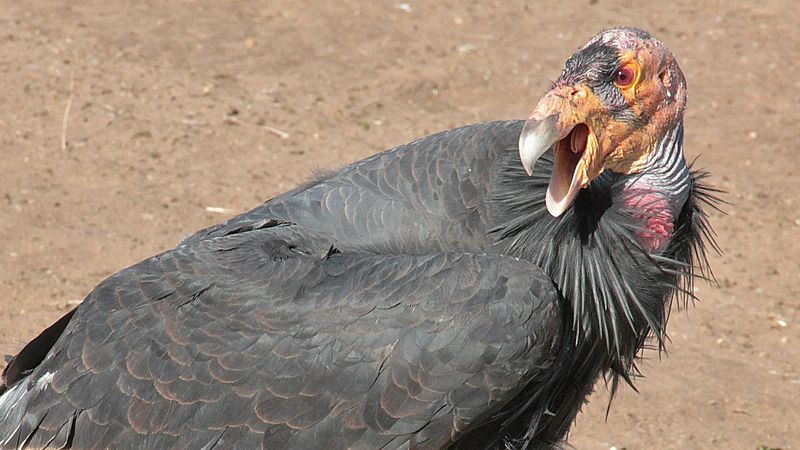Image: California condor at Bitter Creek NWR (6391185515)

Description: The adult California Condor is a uniform black, with the exception, especially in the male, of large triangular patches or bands of white on the underside of the wings. It has gray legs and feet, an ivory-colored bill, a frill of black feathers surrounding the base of the neck, and brownish red eyes. The juvenile is mostly a mottled dark brown with blackish coloration on the head. It has mottled gray instead of white on the underside of its flight feathers. As an adaptation for hygiene, the condor's head and neck have few feathers, which exposes the skin to the sterilizing effects of dehydration and solar ultraviolet light at high altitudes. The skin of the head and neck is capable of flushing noticeably in response to emotional state, a capability that can serve as communication between individuals. The skin color varies from yellowish to a glowing reddish-orange. Contrary to the usual rule among true birds of prey, the female is slightly smaller than the male. Overall length can range from 109–140 cm (43–55 in) and the wingspan is 2.49–3 m (8.2–9.8 ft). Their weight can range from 7–14.1 kg (15–31 lb), with estimations of average weight ranging from 8–9 kg (18–20 lb). Wingspans of up to 3.4 m (11 ft) have been reported but no wingspan over 3 m (9.8 ft) has been verified. Most measurements are from birds raised in captivity, so determining if there are any major differences in measurements between wild and captive condors is difficult. Juvenile: California Condors have the largest wingspan of any North American bird. They are surpassed in both body length and weight only by the Trumpeter Swan and the introduced Mute Swan. The American White Pelican and Whooping Crane also have longer bodies than the condor. Condors are so large that they can be mistaken for a small, distant airplane, which possibly occurs more often than they are mistaken for other species of bird. The middle toe of the California Condor's foot is greatly elongated, and the hind one is only slightly developed. The talons of all the toes are straight and blunt, and are thus more adapted to walking than gripping. (Photo: Scott Flaherty/USFWS)
Title: California condor at Bitter Creek NWR (6391185515)
Credit: California condor at Bitter Creek NWR
Author: Pacific Southwest Region from Sacramento, US
Usage Terms: Public domain
License: Public domain
Attribution Required?: No
Image usage
The following page links to this image:

